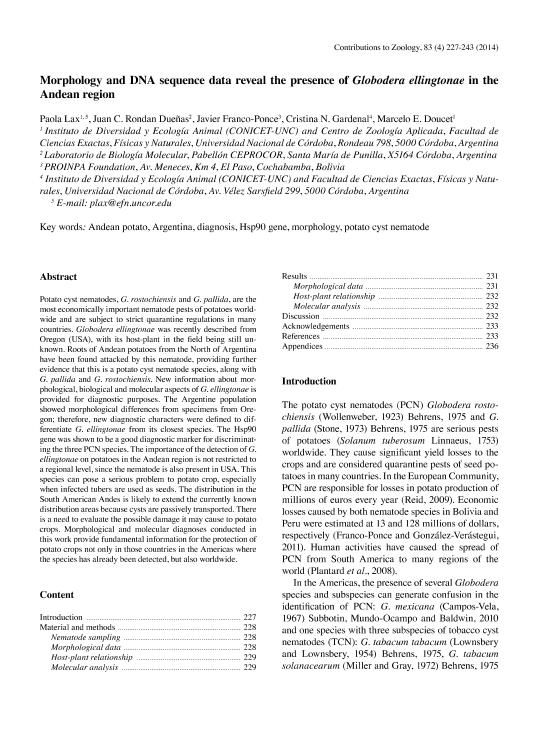Artículo
Morphology and DNA sequence data reveal the presence of Globodera ellingtonae in the Andean region
Lax, Paola ; Rondan Dueñas, Juan; Franco Ponce, Javier; Gardenal, Cristina Noemi
; Rondan Dueñas, Juan; Franco Ponce, Javier; Gardenal, Cristina Noemi ; Doucet, Marcelo Edmundo
; Doucet, Marcelo Edmundo
 ; Rondan Dueñas, Juan; Franco Ponce, Javier; Gardenal, Cristina Noemi
; Rondan Dueñas, Juan; Franco Ponce, Javier; Gardenal, Cristina Noemi ; Doucet, Marcelo Edmundo
; Doucet, Marcelo Edmundo
Fecha de publicación:
2014
Editorial:
University of Amsterdam
Revista:
Contributions To Zoology
ISSN:
0067-8546
e-ISSN:
1875-9866
Idioma:
Inglés
Tipo de recurso:
Artículo publicado
Clasificación temática:
Resumen
Potato cyst nematodes, G. rostochiensis and G. pallida, are the most economically important nematode pests of potatoes worldwide and are subject to strict quarantine regulations in many countries. Globodera ellingtonae was recently described from Oregon (USA), with its host-plant in the field being still unknown. Roots of Andean potatoes from the North of Argentina have been found attacked by this nematode, providing further evidence that this is a potato cyst nematode species, along with G. pallida and G. rostochiensis. New information about morphological, biological and molecular aspects of G. ellingtonae is provided for diagnostic purposes. The Argentine population showed morphological differences from specimens from Oregon; therefore, new diagnostic characters were defined to differentiate G. ellingtonae from its closest species. The Hsp90 gene was shown to be a good diagnostic marker for discriminating the three PCN species. The importance of the detection of G. ellingtonae on potatoes in the Andean region is not restricted to a regional level, since the nematode is also present in USA. This species can pose a serious problem to potato crop, especially when infected tubers are used as seeds. The distribution in the South American Andes is likely to extend the currently known distribution areas because cysts are passively transported. There is a need to evaluate the possible damage it may cause to potato crops. Morphological and molecular diagnoses conducted in this work provide fundamental information for the protection of potato crops not only in those countries in the Americas where the species has already been detected, but also worldwide.
Palabras clave:
Andean Potato
,
Diagnosis
,
Hsp90 Gene
,
Morphology
,
Potato Cyst Nematode
Archivos asociados
Licencia
Identificadores
Colecciones
Articulos(IDEA)
Articulos de INSTITUTO DE DIVERSIDAD Y ECOLOGIA ANIMAL
Articulos de INSTITUTO DE DIVERSIDAD Y ECOLOGIA ANIMAL
Citación
Doucet, Marcelo Edmundo; Gardenal, Cristina Noemi; Franco Ponce, Javier; Rondan Dueñas, Juan; Lax, Paola; Morphology and DNA sequence data reveal the presence of Globodera ellingtonae in the Andean region; University of Amsterdam; Contributions To Zoology; 83; 4; 2014; 227-243
Compartir



